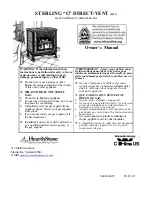
SmartPlate Installation, Operation & Maintenance Manual
CHAPTER 3
– FUNCTIONAL DESCRIPTION
OMM-0069_0H
• SP-100 • 1/30/2020 Technical Support • (800) 526-0288 • Mon-Fri, 8 am - 5 pm EST Page
24
of
134
3.3 ELECTRONIC CONTROL OVERVIEW
The primary control mechanism for the ECS/SP is an Electronic Process Controller which is
installed in the Control Box. The Controller utilizes feed forward and PID (Proportional Integral
Derivative) algorithms to provide precise control of the
unit’s outlet temperature. Outlet
temperature control is accomplished by modulating the open/closed position of the MXG-461
Control Valve Actuator.
The Controller continuously monitors the
unit’s outlet temperature via a thermocouple located in
the outlet port. The Controller also receives a feed-forward signal from the temperature sensor
mounted in the mixed water mixing box as shown in Figure 3-1. The mixed water sensor
monitors flow changes through the unit and provides a feed-forward signal to the Controller
proportional to the change in flow. The mixed water temperature provides an instantaneous
feed-forward response for loads ranging from 0.5 GPM to the maximum Water Heater flow. The
Water Heater uses a cartridge circulator to create reliable mixed flow conditions in the mixing
box.
The Controller provides a 0-to-10 VDC output signal to the MXG-461 Control Valve Actuator.
This 0 to 10 VDC signal proportionally modulates the Control Valve position from fully closed (0
VDC) to fully open (10 VDC). The control signal varies as necessary to maintain the setpoint
temperature programmed into the Controller. Under normal conditions,
the unit’s outlet
temperature is maintained within ±4°F of the desired setpoint based on a load change of 50% or
less. Surface-mount sensors and digital displays are also provided in the ECS/SP Control
System to monitor the supply and return water temperatures of the boiler water.
3.4 OVER-TEMPERATURE CONTROL AND SAFETY FEATURES
The Control Box contains an Over-Temperature Switch which continuously monitors and
displays the
unit’s outlet water temperature from input received from the thermocouple installed
in the hot water outlet port. Normally, the Over-Temperature Switch is set 20°F above the
unit’s
setpoint temperature. If the programmed over-temperature limit is exceeded, the Over-
Temperature Switch is activated. This in turn sounds an audible alarm, disconnects power from
the Control Valve Actuator moving the Control Valve to the full-bypass position (B
– AB). It
should be noted that the Over-Temperature Switch has a slightly slower response to
temperature changes than the Temperature Controller. Therefore, slightly different temperature
readings may appear momentarily in their respective displays, particularly during system start-
up.
The Control Valve Actuator also
incorporates a “Fail-Safe” feature which automatically closes
the valve if there is a loss of the 0 to 10 VDC control signal or loss of input power. The 24 VAC
power supply transformer has an integral 3 amp circuit breaker to protect the Control Valve
electronics.
















































